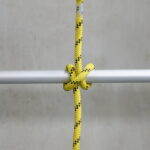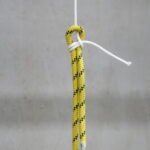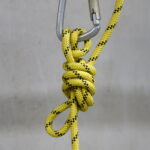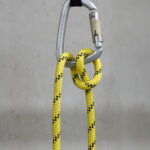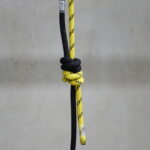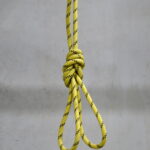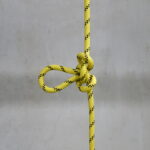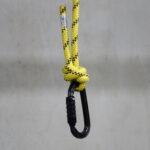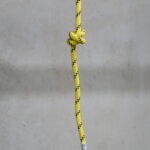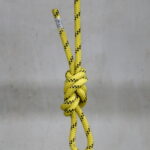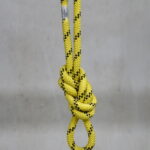What knots do you use for rope access?
Appropriately trained personnel may use knots in an industrial setting. Sewn and swaged terminations are often used as an alternative to knots because they require less training to use and are generally stronger. However, knots allow customization and adaptation of systems to apply the best fit for the environment, risks and execution.
The common knots used for rope access are:
- Figure 8 (on a bight)
- Figure 9 (on a bight)
- Alpine Butterfly
- Stopper Knot
- Barrel Knot
- Double figure of 8 (on a bight) AKA Bunny’s ears
Advanced knots are less common but are used for specific functions such as connecting ropes, friction and gripping other ropes. These knots include:
- Double Fishermans
- Munter
- Mule
- Prussic
Other Knots not traditionally trained in rope access courses are still used on sites as they have quick and helpful applications. The knots are:
- Bowline
- Clove Hitch
- Slip Knot
- Double Sheet bend
The Description, Common uses, Pros and Cons of all these are listed below.
Common Knots
Figure 8 (on a bight)
| Image | Description | Common uses | Pros & Cons |
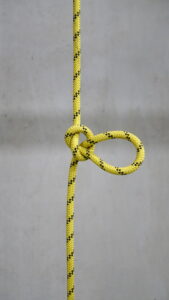 |
a secure loop using a rope bight
|
Terminating Knot,
attaching to carabiners, devices, anchors and rethreading through a harness. |
A few variations to fit the purpose.
it doesn’t bind under normal loads. It can be undone easily. Harder to dress than other terminating knots |
Figure 9 (on a Bight)
| Image | Description | Common uses | Pros & Cons |
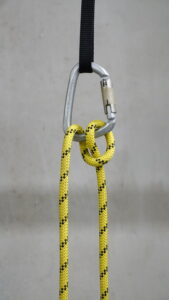 |
a secure loop using a rope bight
|
Terminating Knot, attaching to devices, anchors and carabiners | Easy to dress. suitable for smaller-diameter ropes and cords.
larger knot using more rope. |
Alpine Butterfly
| Image | Description | Common uses | Pros & Cons |
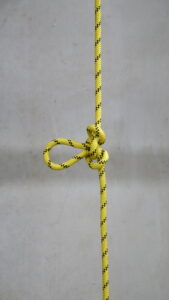 |
Provides a secure loop in the middle of a piece of rope. | Load sharing, damage in rope isolation, temporary mid-line attachment point. | Load can be safely applied in all directions at the same time.
Isolate damaged rope. Confusing tying techniques may create the wrong knot. |
Stopper Knot
| Image | Description | Common uses | Pros & Cons |
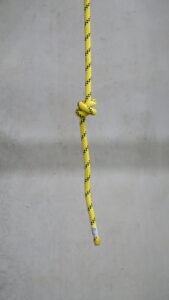 |
A moderate-size, reliable knot | Stopper knot at the end or ropes | Small in size to not get caught.
if not set properly can untie or roll off. |
Barrel Knot AKA Scaffold Knot
| Image | Description | Common uses | Pros & Cons |
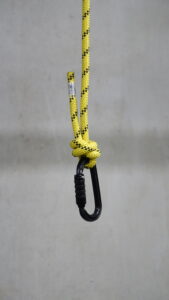 |
A secure constricting loop | Terminating knot, Carabiner attachment for lanyards coming from harness | Secures and constricts under load to stop carabiners rotating.
small size. Hard to undo after loading. can easily be tied incorrectly. |
Double Figure 8 (on a Bight) AKA Bunny’s Ears
| Image | Description | Common uses | Pros & Cons |
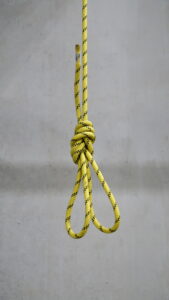 |
Makes a secure double loop using a rope bight | A terminating load-sharing Knot to attach to anchors. Multi-point attachment, Bridal | Quick load share.
easily adjustable. Difficult to tie with large loops. |
Advanced Knots
Double Fisherman’s
| Image | Description | Common uses | Pros & Cons |
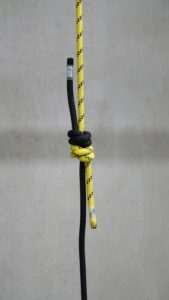 |
Securely joins two ropes of similar size | Joining two ropes together, Creating a continuous loop in the cord. | Compact knot that rolls well.
Lock up very tightly after a load is applied. |
Munter Hitch
| Image | Description | Common uses | Pros & Cons |
 |
Slide and Grip Knot to control friction | Lowering equipment with friction | Quick simple one carabiner hitch,
Self-orienting. Twists and wears rope. |
Mule
| Image | Description | Common uses | Pros & Cons |
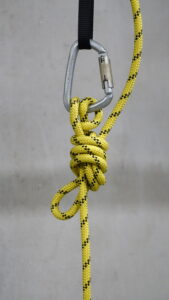 |
Locking Knot used to secure the Munter hitch when not in use | Locking off munter, a quick release knot. | Slide and tighten to lock off.
High loads can become difficult to untie. |
Prussic
| Image | Description | Common uses | Pros & Cons |
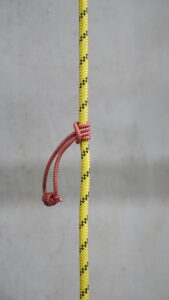 |
slide and grip friction knot | Adjustable point of attachment. Back up when lowering with non-locking devices. Attaching rope protectors | Binds easily, easily released.
Three-turn variant can be released by accidental contact. |
Other Knots
Bowline
| Image | Description | Common uses | Pros & Cons |
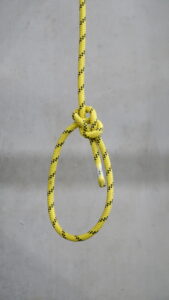 |
Reasonably secure loop in a rope’s end | Tying through an eyelet or unopenable loop to capture. | Easily undone.
Less secure than Figure 8 or 9 |
Clove Hitch
| Image | Description | Common uses | Pros & Cons |
 |
Temporary hold | Temporary tie-off, Lifting as part of multiple knots tied | Quick to tie.
Holds well when load is applied. It can slip and paradoxically, bind. It should be deeply distrusted when used by itself without locking off. |
Slip Knot
| Image | Description | Common uses | Pros & Cons |
 |
Quick releasing knot | Jamming to hold when preparing, Rope movement marker for tension or anchor systems. | Easily released and can be tied anywhere.
Loop Functions as a noose when loaded below. |
Double Sheet Bend
| Image | Description | Common uses | Pros & Cons |
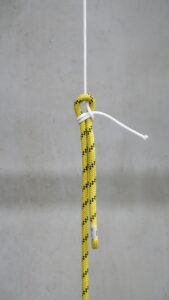 |
Joins two ropes of unequal size | Hauling rope or cable with smaller rope or cord. | Works with significant rope diameter difference.
If load is applied inconsistently can untie. |
For More Information on The Rope Access system: Rope Access Advantage
For projects that have used rope access: Projects



